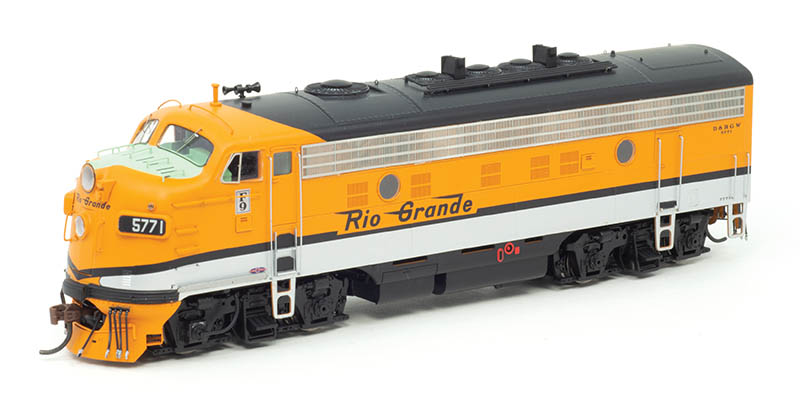
ABOVE: Rio Grande’s most-famous F-unit was this F9A, released by Athearn Genesis in September 2020.
General Motors’ Electro-Motive Division built a pair of F9A units (5771 and 5774) and four F9B boosters (5753, 5763, 5772, and 5773) for Denver & Rio Grande Western (D&RGW) in September 1955. A few months into their service lives on Rio Grande, the road renumbered 5753 to 5762 (according to Don Strack’s Utah Rails, this was a swap with F7B 5753 and done to keep a consecutive numbering series).
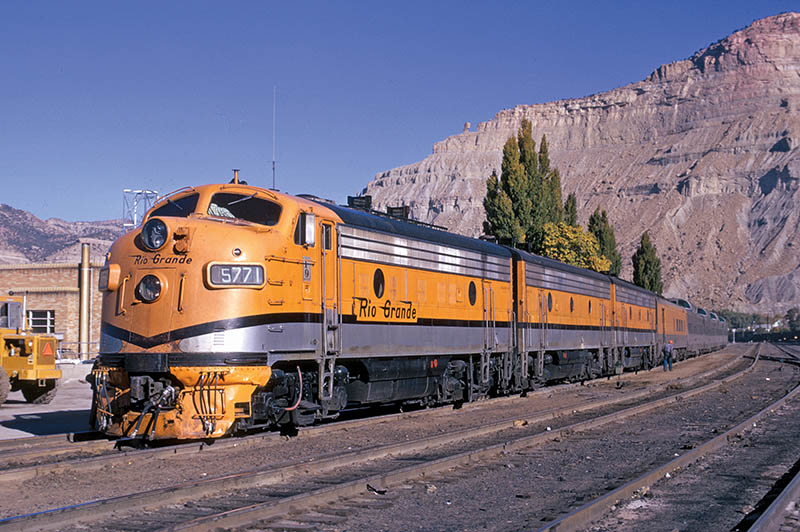
ABOVE: Rio Grande 5771 and the surviving F9Bs (5762 and 5763) pause with the Rio Grande Zephyr at Helper, Utah, on October 20, 1974. -Joe Brockmeyer photo, Kevin EuDaly collection
Though 5771 gained amazing fame leading the road’s Amtrak holdout Rio Grande Zephyr service during the 1970s and into the 1980s, the collection F9s didn’t all enjoy long and lucky lives. In September 1965, F9B 5772 left the roster after being wrecked in Glenwood Canyon in western Colorado. The unit was traded in for credit on an order of GP40s. Less than three years later 5771’s twin F9A 5774 and F9B 5773 were involved in a wreck (also in Glenwood Canyon at Grizzly) and later both sold for scrap.
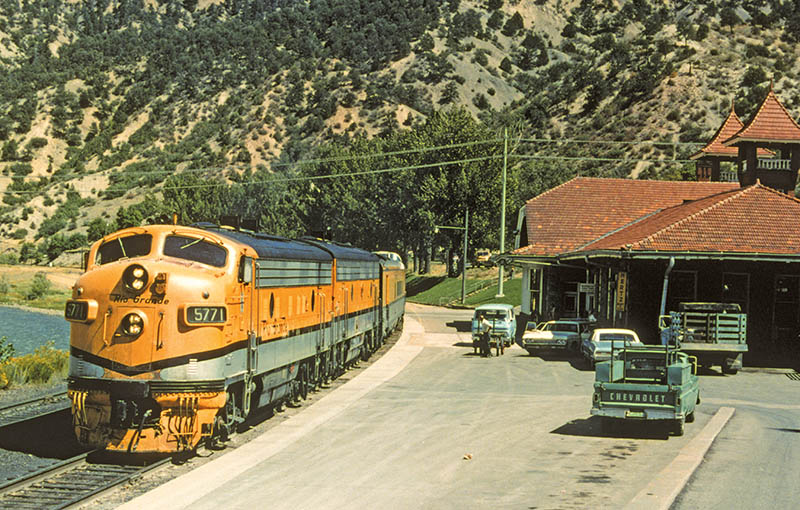
ABOVE: Rio Grande 5771 and one of the F9Bs leads what must be a short RGZ consist at Glenwood Springs, Colo., in September 1972. -Ed Fulcomer photo, Kevin EuDaly collection
Following these mishaps in Glenwood Canyon in 1965 and 1968, this left Rio Grande’s F9 roster with a single A-unit (5771) and a two F9Bs (5762 and 5763). With the 1970s ahead, most passenger power of this type was moving to freight assignments or retirement. This trio of Aspen Gold and silver F-units stuck to their people carrying duties and became the stars of Rio Grande’s tri-weekly Denver to Salt Lake City service dubbed the Rio Grande Zephyr.
Beginning in 1949, Rio Grande joined with Chicago, Burlington & Quincy (CB&Q) and Western Pacific (WP) and provided the famed California Zephyr service between Chicago and Oakland (San Francisco). This legendary train was equipped with Budd-built Vista-Dome cars and was a standout among long-distance U.S. passenger trains in the post-World War II era. By the late 1960s, Western Pacific’s financial situation and the general decline in ridership, caused that road to request permission from the U.S. government to discontinue it’s leg (Salt Lake City to Oakland) of the CZ. In March 1970, the request was granted and Rio Grande along new road Burlington Northern (created from CB&Q; Great Northern; Northern Pacific; and Spokane, Portland & Seattle) operated “California Service” with connection with Southern Pacific at Ogden, Utah. When Amtrak came into being on May 1, 1971, Burlington Northern handed over the operation of its passenger trains, as did most U.S. roads, to this new nationwide passenger carrier.
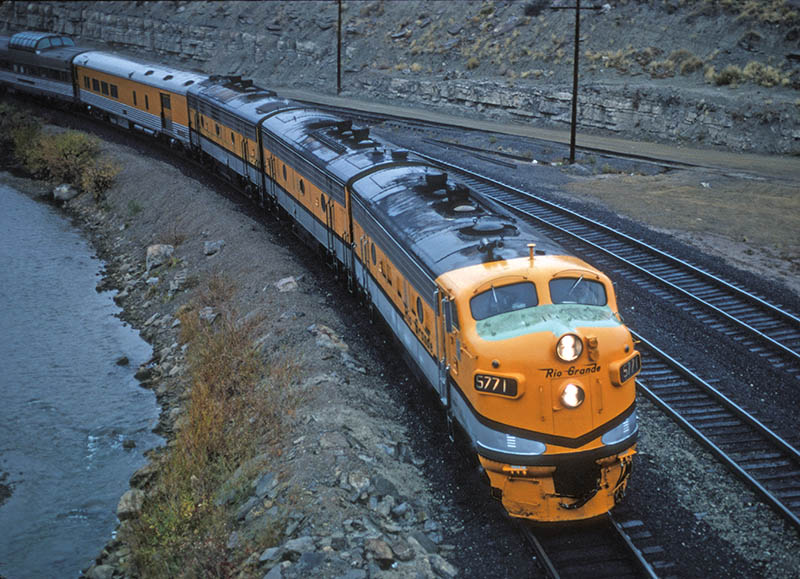
ABOVE: Compare the nose and roof detail between Rio Grande’s 5771 and Athearn’s Genesis HO-scale release. This view of the RGZ finds the train crossing Soldier Summit, Utah on a rainy late October day in 1978. -Peter Arnold photo, Kevin EuDaly collection
Rio Grande, along with a few railroads including Rock Island and Southern Railway, abstained from Amtrak in 1971. Do so meant Rio Grande had to continue its current passenger services for five years until they could be up for cancellation by the U.S. Interstate Commerce Commission. Those early 1970s editions of the RGZ were often short consists and the train might have seemed like a good bet for discontinuance in 1976. However, railfans and the nostalgic members of the traveling public helped make this train more popular as the 1970s went onward. By the late 1970s, you could find summer season consists swelled to the point of running virtually the entire collection of ex-CZ cars in D&RGW’s fleet.
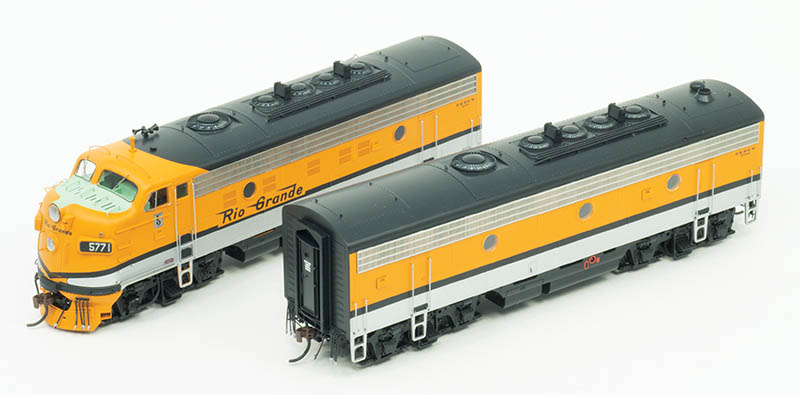
ABOVE: Athearn’s HO-scale Genesis F9A and F9B (D&RGW 5771 and 5762) present a classic 1970s appearance for the road’s RGZ motive power.
All good things must come to an end the saying goes, and for RGZ fans that happened in April 1983. Rio Grande negotiated a deal with Amtrak allow the road to move its San Francisco Zephyr service from Union Pacific’s Overland Route between Denver and Salt Lake City over to Rio Grande’s famous “Moffat Road” between the same two cities. The early 1980s Amtrak service was now under the command of F40PH diesel locomotives and recently delivered Superliner cars, this revised route took on the California Zephyr name… though WP’s end of the route via the Feather River Canyon was not included on Amtrak’s map (the CZ would cover Southern Pacific’s lines across Nevada and California via Donner Pass).
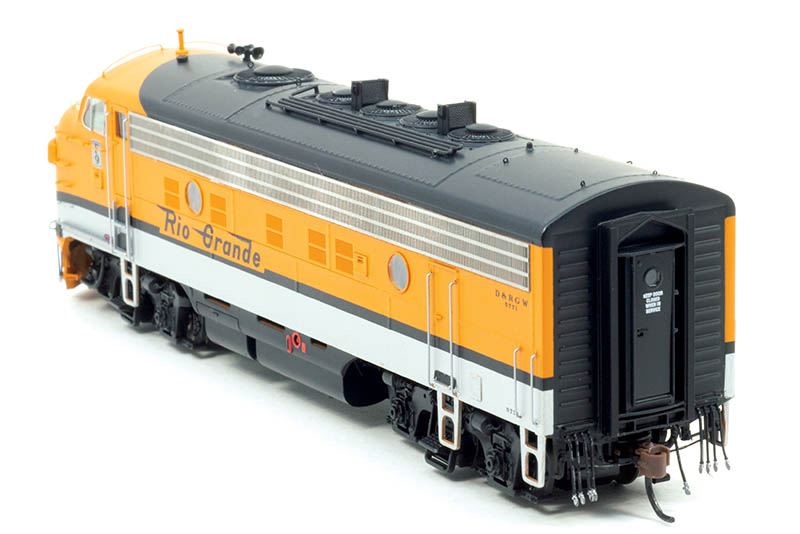
ABOVE: Athearn’s highly detailed HO-scale Genesis series Rio Grande F-units are sold in A-B pairings and single unit releases.
The F-units may have been without Rio Grande Zephyr duties in the spring of 1983, but they remained on the roster. Railfans occasionally could find these mid-1950s now-vintage F-units working the season Ski Train service between Denver and Winter Park, Colo. The units also pulled some mundane low-priority work for the road during these years.

ABOVE: The late-era look for Rio Grande 5771 included a smooth-face replacement pilot created by the road’s Burnham Shops following a grade crossing incident in 1980. The Rio Grande Zephyr is westbound near Tunnel 1 at Plainview, Colo., in April 1983 near the end of its days. The second unit is a rebuilt Alco PB-1 that became a steam generator car in the 1960s. -David M. Johnston photo, Kevin EuDaly collection
Rio Grande took over Southern Pacific in 1988 and both roads became part of Union Pacific’s system in 1996. In September 1996, Golden’s Colorado Railroad Museum in the Denver area received 5771 and 5762. The pair was cosmetically restored to Rio Grande’s four-stripe Aspen Gold and silver livery. The other F9B (D&RGW 5763) sat in Cheyenne, Wyo., and remained inactive for many years. In early 2019, this F9B was taken to NMI Industrial in Sacramento, Calif., and rebuilt and now serves as a SMPW 222 (a power unit for rotary snowplow operations) and is assigned to Roseville, Calif.
Athearn’s 2020 release of Genesis HO-scale F9s decorated for Rio Grande include single-stripe Aspen Gold and silver livery with two sets of F9A/F9B units (5771/5762 and 5774/5772) and single F9B release featuring DR&GW 5763. These models were produced in standard DC version and in releases equipped with Digital Command Control and sound output. Watch for a review of these Athearn Genesis HO-scale Rio Grande F9s in the pages of Model Railroad News magazine.
Athearn Genesis HO-scale
EMD F9A/F9B standard DC
ATHG12345, MSRP: $379.98
Athearn Trains
1600 Forbes Way, Suite 120
Long Beach, CA 90810
310-763-7140


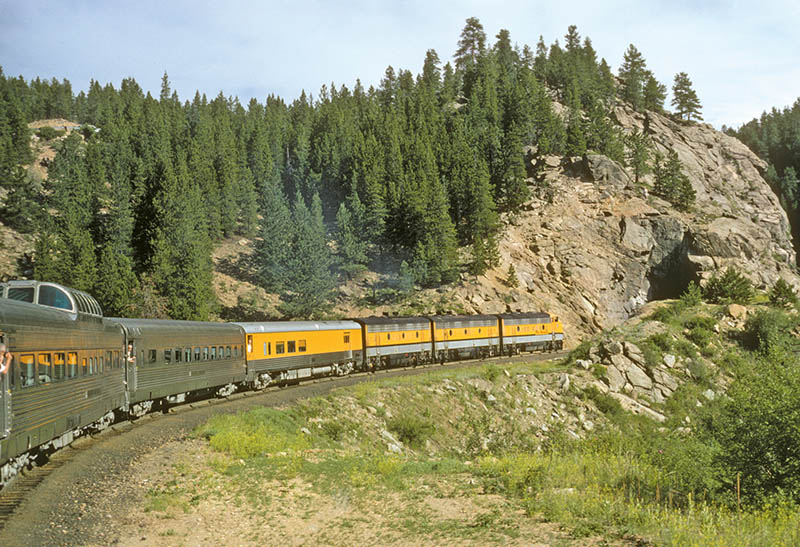
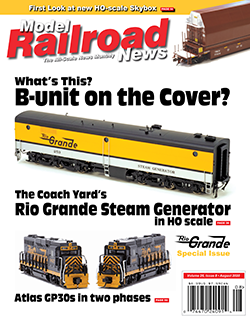 There’s more Rio Grande in the
There’s more Rio Grande in the 